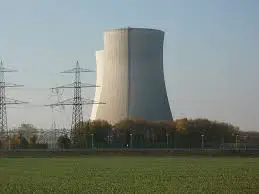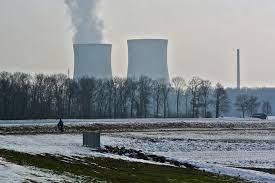In the United States for instance, people are typically exposed to about 350 millirems of ionizing radiation per year. On average, 82% of this radiation comes from natural sources and 18% from anthropogenic sources (i.e., those associated with human activities).
The major natural source of radiation is radon gas, which accounts for about 55% of the total radiation dose. The principal anthropogenic sources of radioactivity are medical X-rays and nuclear medicine.
Radioactivity from the fallout of nuclear weapons testing and from nuclear power plants make up less than 0.5% of the total radiation dose, i.e., less than 2 millirems.
Although the contribution to the total human radiation dose is extremely small, radioactive isotopes released during previous atmospheric testing of nuclear weapons will remain in the atmosphere for the next 100 years.
Causes of Radioactive Pollution
Some of the causes of radioactive pollution are discussed below:
Nuclear power plants accidents
Many environmentalists are critical of nuclear power generation. They believe that there is an unacceptable risk of catastrophic accident, that the spread of nuclear energy technology increases the risk of nuclear weapons proliferation, and that the nuclear fuel cycle generates large amounts of unmanageable nuclear waste that will represent a long-term danger to human well-being.
In particular, a nuclear reactor can expose an individual who lives on the fence line of the power plant to no more than 10 millirems of radiation per year.
Actual measurements at U.S. nuclear power plants have shown that a person who lived at the fence line would actually be exposed to much less that 10 millirems.
Read Also : How to Locate Electronic Recycling Near Me
Although a nuclear power plant cannot explode like an atomic bomb, accidents can result in serious radioactive pollution.
During the past 45 years, there have been a number of not-fully controlled or uncontrolled fission reactions at nuclear power plants in the United States and elsewhere, which have killed or injured power plant workers.
These accidents occurred in Los Alamos, New Mexico; Oak Ridge, Tennessee; Richland, Washington; and Wood River Junction, Rhode Island.
The most famous case was the 1979 accident at the Three Mile Island nuclear reactor in Pennsylvania, which received a great deal of attention in the press.
However, nuclear scientists have estimated that people living within 50 mi (80 km) of this reactor were exposed to less than two millirems of radiation, most of it as iodine-131, a short-lived isotope.
This exposure constituted less than 1% of the total annual radiation dose of an average person. However, these data do not mean that the accident at Three Mile Island was not a serious one; fortunately, technicians were able to re-attain control of the reactor before more devastating damage occurred, and the reactor system was well contained so that only a relatively small amount of radioactivity escaped to the ambient environment.
By far, the worst nuclear reactor accident occurred in 1986 in Chernobyl, Ukraine. An uncontrolled build-up of heat resulted in a meltdown of the reactor core and combustion of graphite moderator material in one of the several generating units at Chernobyl, releasing more than 50 million Curies of radioactivity to the ambient environment.
The disaster killed 31 workers, and resulted in the hospitalization of more than 500 other people from radiation sickness.
According to Ukrainian authorities, during the decade following the Chernobyl disaster an estimated 10,000 people in Belarus, Russia, and Ukraine died from cancers and other radiation-related diseases caused by the accident.
In addition to these relatively local effects, the atmosphere transported radiation from Chernobyl into Europe and throughout the Northern Hemisphere.
More than 500,000 people in the vicinity of Chernobyl were exposed to dangerously high doses of radiation, and more than 300,000 people were permanently evacuated from the vicinity.
Since radiation-related health problems may appear decades after exposure, scientists expect that many thousands of additional people will eventually suffer higher rates of thyroid cancer, bone cancer, leukemia, and other radiation-related diseases.
Unfortunately, a cover-up of the explosion by responsible authorities, including those in government, endangered even more people. Many local residents did not known that they should flee the area as soon as possible, or were not provided with the medical attention they needed.
After the great east-Japan earthquake of magnitude 9.0 and tsunami on the east coast of northern Japan on 11 March 2011, the Fukushima-Daiichi nuclear power station was severely damaged and radioactive material was released to the environment.
Approximately 85 000 residents within the 20-km area around the nuclear power station site and some nearby areas were evacuated as a precautionary measure between 11 and 15 March, while the residents living 20–30 km from the station were sheltered in their own homes.
Later, in April 2011, the evacuation of another 10 000 people living further to the north-east of the station was recommended because of the elevated levels of radionuclides on the ground. These evacuations greatly reduced the levels of exposure that would have been received by those affected.
The consumption of water and certain foodstuffs was temporarily restricted to limit the radiation exposure of the public. In managing the emergency situation at the nuclear power station, some operational staff and emergency response personnel were exposed.
The large amount of radioactive waste generated by nuclear power plants is another important problem. This waste will remain radioactive for many thousands of years, so technologists must design systems for extremely long-term storage.
One obvious problem is that the long-term reliability of the storage systems cannot be fully assured, because they cannot be directly tested for the length of time they will be used (i.e., for tens or hundreds of thousands of years).
A related problem is that the waste will remain extremely dangerous for much longer than the expected lifetimes of existing governments and social institutions.
Nuclear weapons testing
Nuclear weapons can release large amounts of radioactive materials when they are exploded.
Most of the radioactive pollution from nuclear weapons testing is from iodine-131, cesium-137, and strontium-90. Iodine-131 is the least dangerous of these isotopes, although it has a relatively half-life of about eight days. Iodine-131 accumulates in the thyroid gland, and large doses can cause thyroid cancer.
Cesium-137 has a half-life of about 30 years. It is chemically similar to potassium, and is distributed throughout the human body. Based on the total amount of cesium already in the atmosphere, all humans will receive about 27 millirems of radiation from cesium- 137 over their lifetime.
Strontium-90 has a half-life of 38 years. It is chemically similar to calcium and is deposited in bones. Strontium-90 is expelled from the body very slowly, and the uptake of significant amounts increases the risks of developing bone cancer or leukemia.
The use of nuclear weapons as weapons of mass destruction (WMD)
The use of nuclear missiles and atomic bombs, a form of nuclear energy, in the Second World War explains not only the cause but also the damaging nature of radioactive pollution or contamination.

The effects of those two strikes in Hiroshima and Nagasaki that prompted the end of the war in 1945 have been seen to date with children born with complications such as mental retardation as well as conditions like autism and other disorders.
The number of cancer cases present in the two towns is more than those of the rest of Japan.
Mining
Mining mostly involves the excavation of the mineral ores, which are then broken into smaller, manageable pieces. Radium and Uranium, for instance, are naturally occurring in the environment and are equally radioactive.
Hence, mining increases the natural geological processes by moving these materials from underneath the earth to the surface.
Other minerals with a hint of radiation are thorium, plutonium, radon, potassium, carbon and phosphorus.
Spillage of radioactive chemicals
There have been instances of spillages over oceans when ships hit glaciers or coral reefs and end up releasing chemicals on waterways and in the atmosphere.
The majority of these chemicals, including petroleum products, have a significant level of radiation, which can be detrimental to the environment.
Cosmic rays and other natural sources
These come from the outer space to our planet with intense radiation as their nature, therefore, causing radioactive pollution.
Gamma rays, for example, are said to have the highest level of radiation and yet, depending on their intensity, some are not visible to the human eye. The quantity with which the rays hit the earth depends on the altitude of the earth and the geographical location.
There may be terrestrial radiations from radioactive elements present in the earth‘s crust. These radioactive elements include potassium 40, radium 224, radon 222, thorium 232, uranium 235, uranium 238, and carbon 14 and occur in rocks, soil and water.
There can also be unstable radio-nuclides split into smaller parts emitting energetic radiation that can enter into the body of organisms through the air during respiration.
Lifestyle and Radiation Dose
People who live in certain regions are exposed to higher doses of radiation. For example, residents of the Rocky Mountains of Colorado receive about 30 millirems more cosmic radiation than people living at sea level.
This is because the atmosphere is thinner at higher elevations, and therefore less effective at shielding the surface from cosmic radiation.
Exposure to cosmic radiation is also high while people are flying in an airplane, so pilots and flight attendants have an enhanced, occupational exposure. In addition, residents of certain regions receive higher doses of radiation from radon-222, due to local geological anomalies.
Radon-222 is a colorless and odorless gas that results from the decay of naturally occurring, radioactive isotopes of uranium. Radon-222 typically enters buildings from their basement, or from certain mineral- containing construction materials.
Ironically, the trend toward improved home insulation has increased the amount of radon-222 which remains trapped inside houses.
Personal lifestyle also influences the amount of radioactivity to which people are exposed. For example, miners, who spend a lot of time underground, are exposed to relatively high doses of radon-222 and consequently have relatively high rates of lung cancer.
Cigarette smokers expose their lungs to high levels of radiation, since tobacco plants contain trace quantities of polonium- 210, lead-210, and radon-222. These radioactive isotopes come from the small amount of uranium present in fertilizers used to promote tobacco growth.
Consequently, the lungs of a cigarette smoker are exposed to thousands of additional millirems of radioactivity, although any associated hazards are much less than those of tar and nicotine.
In summary, the use of nuclear missiles and atomic bombs, a form of nuclear energy, in the Second World War explains not only the cause but also the damaging nature of radioactive pollution or contamination.
Read Also : Industrial Wastewater Treatment Process
The principal anthropogenic sources of radioactivity are medical X-rays and nuclear medicine.
Cigarette smokers expose their lungs to high levels of radiation, since tobacco plants contain trace quantities of polonium-210, lead-210, and radon-222.
Although a nuclear power plant cannot explode like an atomic bomb, accidents can result in serious radioactive pollution. By far, the worst nuclear reactor accident occurred in 1986 in Chernobyl, Ukraine.
An uncontrolled build-up of heat resulted in a meltdown of the reactor core and combustion of graphite moderator material in one of the several generating units at Chernobyl, releasing more than 50 million Curies of radioactivity to the ambient environment.
The disaster killed 31 workers, and resulted in the hospitalization of more than 500 other people from radiation sickness.
Personal lifestyle also influences the amount of radioactivity to which people are exposed. For example, miners, who spend a lot of time underground, are exposed to relatively high doses of radon-222 and consequently have relatively high rates of lung cancer.

